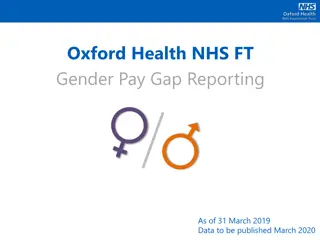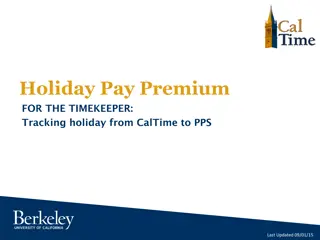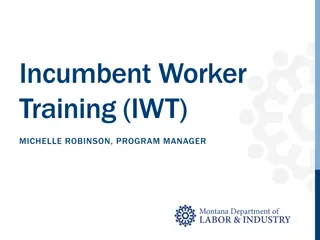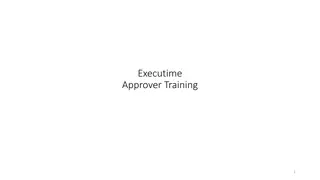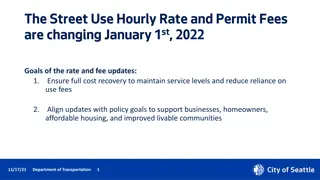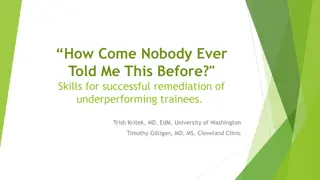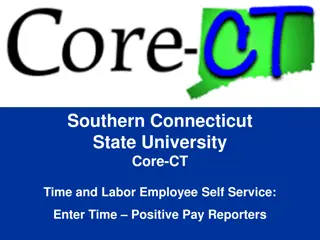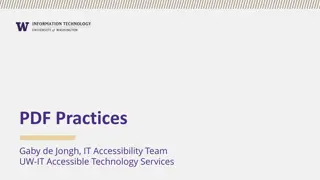Remediation Strategies for Part-Time and Variable Hourly Employees in Holiday Act Compliance
This case study delves into the challenges faced in managing leave liabilities for part-time and variable hourly employees under the Holidays Act 2003. It explores various working profiles such as split shifts, cycle shifts, variable shifts, and seasonal work, presenting issues in calculating leave entitlements. The study emphasizes the importance of accurately determining employees' working weeks and average hours to ensure compliance with employment agreements and entitlements.
Download Presentation

Please find below an Image/Link to download the presentation.
The content on the website is provided AS IS for your information and personal use only. It may not be sold, licensed, or shared on other websites without obtaining consent from the author.If you encounter any issues during the download, it is possible that the publisher has removed the file from their server.
You are allowed to download the files provided on this website for personal or commercial use, subject to the condition that they are used lawfully. All files are the property of their respective owners.
The content on the website is provided AS IS for your information and personal use only. It may not be sold, licensed, or shared on other websites without obtaining consent from the author.
E N D
Presentation Transcript
A Case Study Remediation for Part Time and Variable hourly paid employees
Remediation calculations for part time and variable hourly paid employees - Its what the Holidays Act 2003 (ACT) was never really designed to manage. - well at least not easily So, what was the ACT designed for: Full time or part time employees that worked 5 day a week employee s On the same hours each day
Working profiles are very diverse and create issues when calculating leave liabilities for: Split shifts - Bus drivers, hotel workers Cycle shifts longer in duration than the pay period - Industry specific Variable shifts - Petrol stations, fast food operators, bars, restaurants and care workers Seasonal work - differential between summer and winter and/or with closedowns
The example today is from an Industry where their employees have the following employment conditions: Employed on IEC and/or Collective with the same terms and conditions (800 employees) Were originally employed for a set-number hours per week employment agreement hours) that varied, usually upwards depending on the additional hours they took on. In most cases the additional hours were not made permanent even though in many cases they should have as it varied consistently from their original contracted hours. All staff were given an entitlement of annual leave based on 4/52ths of all hours worked in their anniversary year, which as we know is incorrect.
First Steps in the project: Establish what the working week for an employee is This required calculating the following: Hours of work in the week before leave was taken Average hours over the last 4 weeks Contract hours are also a consideration If the employer had not being paying the employee their contracted hours, at a minimum then there would be an issue (not with this employer though) All employees worked each week apart when they went on holiday or took BAPS leave.
Working week hours Calculated as follows: Week 1 30 hours Week 2 32 hours Week 3 30 hours Week 4 28 hours Average hours per week Last weeks hours 30 hours 28 hours Under our methodology the working week is 30 hours However if OWE is based on the last 4 weeks then you should use this average for the working week.
How to calculate what part of week the employee has taken in annual leave. Once the working week is established the following calculation is completed: Establish the hours of leave being taken i.e. 6 hours Divide that into the working week hours i.e. 30 hours Answer: employee has taken 20% of weeks leave Following this holiday, the employees balance of leave would be as follows: Annual leave entitlement 4.00 weeks Less .20 weeks Balance 3.80 weeks
How to calculate what part of week the employee has taken after working week hours change Establish the hours of leave being taken i.e. 6 hours Divide that into the working week hours i.e. 24 hours Answer: employee has taken 25% of weeks leave Following this holiday, the employees balance of leave would be as follows: Annual leave entitlement Less .25 weeks Balance 3.80 weeks 3.55 weeks Same hours taken however different % of a week
Leave liability $ Payment for annual leave (1stinstance) 20% of the greater of: OWP or AWE Payment for annual leave (2ndinstance) 25% of the greater of OWP or AWE Each piece of leave is part of a week that builds to 4 weeks eventually unless termination comes first. Its based on having correct OWP and AWE figures at the time leave was taken or use an adjustment page.
Terminations In the event of a termination an employee would be paid: Payment for annual leave (1stinstance) 380% of the greater of: OWP or AWE Plus 8% of gross taxable earnings following anniversary Payment for annual leave (2ndinstance) 355% of the greater of OWP AWE Plus 8% of gross taxable earnings following anniversary
Remediation calculations Holiday pay shortfalls must add into the period that they were supposed to be made. i.e. Employee underpaid $ 25.00 in a week leave was taken. This gross amount must be added into OWP AWE for last week (or the last 4 weeks if appropriate) for the next 12 months When completing a remediation, employers cannot simply work out the shortfall and add 8% to the total value at the end of the calculation period. Any underpayment has to be included in subsequent calculations from date of shortfall (unless its a backpay .. refer David s last newsletter)
Complex situations Where an employee works 32 hours for the first 6 months and then drops down to 16 hours for the second 6 months (permanent change) They are entitled to 4 weeks at 16 hours as this is their working week. However, the AWE rate is elevated I believe that the ACT should ensure that an employee gets at least 8% of earnings from the use of their entitlement. The employee takes several weeks of LWOP (as defined section 16 ACT) Once an employee takes more than 1 weeks leave without pay their anniversary date can be moved Once 52 working weeks that includes the 1 week above the employee can receive their entitlement It may take an employee 1 year and say 1 month to receive their entitlement
Examples of a spreadsheet developed to manage this remediation Downloaded from payroll system Calculated fields Calculated Gross earnings as at start of recal period from last anniversary 2707.55 Higher of OWP & AWE X % of week taken 164.23 164.12 328.70 502.08 709.59 358.32 343.21 172.20 344.59 177.76 179.26 538.82 609.06 919.19 439.62 184.97 566.41 208.25 187.21 591.25 382.02 373.34 556.23 549.36 181.39 364.01 365.44 180.52 364.64 364.99 732.98 388.56 744.04 182.89 593.63 371.81 368.72 92.55 535.65 177.92 361.08 711.51 367.87 550.70 742.61 379.49 Average Weekly Hours Capped at 40 hours Leave Balance as at start of recalculation period Employee Anniversary Date 16/05/2010 Last 4 weeks hours 160 170 178.25 179.25 179.5 186 162.5 172 178 178 177 177 202 217 209 182 179 206 178 195 188.5 178 182 180 176 176 180 176 176 176 179 178 181 178 184 182 176 178 168 160 176.5 168 177 178 177.5 178 Average Weekly Hours AWE weekly earnings 821.14 820.59 821.75 823.88 841.30 846.81 858.02 861.00 861.48 876.28 892.34 898.04 909.44 922.84 923.07 924.87 944.01 954.16 936.04 940.02 943.59 927.00 903.42 906.73 906.53 910.01 913.60 902.62 911.61 912.47 916.23 910.94 911.54 914.47 919.19 920.26 921.81 925.48 892.74 889.62 890.06 889.39 891.90 897.18 900.95 907.10 OWP Weekly Earnings 756.62 785.81 807.16 836.80 886.99 895.80 767.71 822.14 855.42 888.79 896.29 881.14 1,015.10 1,148.99 1,099.04 906.95 862.62 1,041.23 881.43 985.42 955.04 933.34 927.05 915.59 906.94 894.40 897.43 889.76 889.18 888.28 897.70 971.41 930.05 913.76 989.39 929.52 914.28 892.45 859.22 829.63 902.69 886.96 919.68 917.83 928.26 948.72 Leave Period End 7/11/2010 21/11/2010 19/12/2010 2/01/2011 27/02/2011 27/03/2011 31/07/2011 14/08/2011 28/08/2011 9/10/2011 20/11/2011 18/12/2011 1/01/2012 15/01/2012 12/02/2012 25/03/2012 26/08/2012 9/09/2012 21/10/2012 2/12/2012 16/12/2012 13/01/2013 2/06/2013 16/06/2013 30/06/2013 14/07/2013 25/08/2013 8/09/2013 22/09/2013 6/10/2013 3/11/2013 26/01/2014 9/03/2014 4/05/2014 18/05/2014 15/06/2014 29/06/2014 5/10/2014 20/08/2017 17/09/2017 29/10/2017 12/11/2017 10/12/2017 7/01/2018 18/02/2018 15/04/2018 Leave Hours 8 8 16 24 32 16 16 8 16 8 8 24 24 32 16 8 24 8 8 24 16 16 24 24 8 16 16 8 16 16 32 16 32 8 24 16 16 4 24 8 16 32 16 24 32 16 Leave $ Paid 164.23 164.12 328.70 494.33 673.04 338.72 340.59 170.88 341.96 173.92 177.11 534.71 535.37 724.35 362.26 181.48 559.95 188.65 186.49 561.85 375.99 373.68 548.38 544.04 181.31 364.00 365.44 180.52 361.86 362.20 727.39 361.60 726.44 182.19 549.40 368.10 368.72 92.55 536.28 178.14 356.45 712.37 357.19 538.96 724.07 359.98 AWE Earnings 42699.46 42670.46 42731.08 42841.56 43747.64 44034.13 44616.86 44771.85 44796.78 45566.50 46401.91 46697.84 47290.70 47987.78 47999.61 48092.98 49088.62 49616.20 48673.83 48881.25 49066.77 48204.15 46977.99 47150.03 47139.45 47320.77 47507.12 46936.27 47403.52 47448.45 47643.97 47369.09 47400.22 47552.38 47797.96 47853.67 47934.24 48124.82 46422.62 46260.19 46283.34 46248.46 46378.95 46653.29 46849.40 47169.26 OWP Earnings 3026.48 3143.23 3228.62 3347.20 3547.97 3583.19 3070.82 3288.57 3421.67 3555.16 3585.15 3524.55 4060.40 4595.97 4396.16 3627.80 3450.46 4164.91 3525.73 3941.66 3820.15 3733.35 3708.20 3662.37 3627.77 3577.61 3589.73 3559.02 3556.70 3553.11 3590.81 3885.62 3720.19 3655.02 3957.54 3718.08 3657.12 3569.79 3436.86 3318.51 3610.76 3547.82 3678.71 3671.31 3713.04 3794.88 % of Week taken Emp No 10056 10056 10056 10056 10056 10056 10056 10056 10056 10056 10056 10056 10056 10056 10056 10056 10056 10056 10056 10056 10056 10056 10056 10056 10056 10056 10056 10056 10056 10056 10056 10056 10056 10056 10056 10056 10056 10056 10056 10056 10056 10056 10056 10056 10056 10056 Underpayment 0.2 40 40.00 40.00 40.00 40.00 40.00 40.00 40.00 40.00 40.00 40.00 40.00 40.00 40.00 40.00 40.00 40.00 40.00 40.00 40.00 40.00 40.00 40.00 40.00 40.00 40.00 40.00 40.00 40.00 40.00 40.00 40.00 40.00 40.00 40.00 40.00 40.00 40.00 40.00 40.00 40.00 40.00 40.00 40.00 40.00 40.00 40.00 0.20 0.20 0.40 0.60 0.80 0.40 0.40 0.20 0.40 0.20 0.20 0.60 0.60 0.80 0.40 0.20 0.60 0.20 0.20 0.60 0.40 0.40 0.60 0.60 0.20 0.40 0.40 0.20 0.40 0.40 0.80 0.40 0.80 0.20 0.60 0.40 0.40 0.10 0.60 0.20 0.40 0.80 0.40 0.60 0.80 0.40 0 0 0 42.5 44.5625 44.8125 44.875 46.5 40.625 7.75 36.55 23.26 3.14 1.59 3.19 3.84 2.15 5.05 74.45 210.75 98.43 5.13 11.11 20.15 2.36 29.4 8.97 0.55 7.85 43 44.5 44.5 44.25 44.25 50.5 54.25 52.25 45.5 44.75 51.5 44.5 48.75 47.125 44.5 45.5 45 44 44 45 44 44 44 6.5 0.8 0.68 0.68 0.3 3.23 3.26 6.55 26.96 17.6 0.99 44.38 8.15 0.88 0.21 44.75 44.5 45.25 44.5 46 45.5 44 44.5 42 40 0 0 44.125 4.63 42 0 44.25 44.5 44.375 44.5 10.68 0 0 0 692.15
This page allowances employers to add payments that were not originally in gross taxable earnings Date Employee no AWE OWP 15/11/2017 1030 Bonus 10.00 0.00
Bad habits Many employers have the following bad habits when an employee leaves or skips out without notice: Does not calculate a final pay, just leaves this in the system. Does not pay the hours from the last week. and does not have a clause in their contract that says they can deduct a week or two in lieu of notice. Takes the holiday pay as in lieu of notice Leaves the employee on the books in case they come back (creates issues for them if not terminated with IRD. Employers are obligated to try and find employees to pay their holiday pay. Remember that unclaimed holiday pay goes to unclaimed monies (usually over $ 100.00 pp per year opinion)






